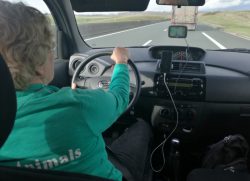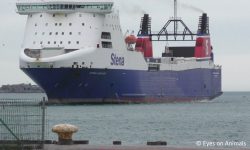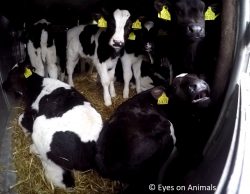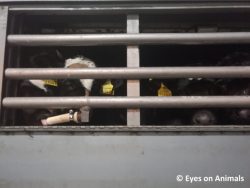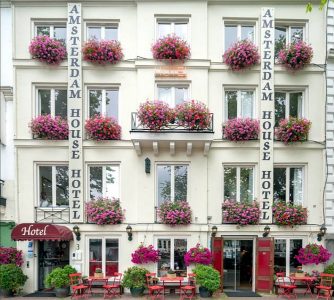On the 13th of March two teams from Eyes on Animals inspected calf trucks leaving Rosslare (IE) Port and heading to Cherbourg Port (FR) via the Stena Roll-on Roll-off ferry service. The trucks were transported by the Stena Carrier ferry that was especially deployed for transporting calves in February and March. There were at least 17 calf trucks onboard the ferry that day. The ferry journey took 19 hours in total (including a 1.5 hour delay). We documented that at least six of the calf trucks that came off the Stena Carrier did not stop at the first available control post, ‘Qualivia’ in Tollevast (near Cherbourg), to unload the calves as they should, according to the EU regulations. Instead they drove to a different Qualivia control post, situated in Abbeville, a further drive of 5 hours resulting in all of these trucks exceeding the maximum allowed transport time of 19 hours (9-1-9) for unweaned calves.
One team trailed one of these calf trucks (transport-company Hallissey) to its final destination; a veal farm in The Netherlands. The total journey took 56hrs 35mins (including the ferry crossing of 19hrs and the rest time of 12hrs at the Qualivia Abbeville, control post). The calves were confined inside the truck for the first leg of the journey lasting 32hrs 11mins, a total of 13hrs 11mins over the maximum time allowed. The driver told us that his journey log indicated the control post in Abbeville and had been approved by the Irish authorities.
During the trailing we observed the loading conditions and welfare of the calves. There was enough bedding and the loading density was acceptable. Some calves on the first level did not have enough headspace and were almost touching the ceiling with their backs. The calves ranged from between 2 and 4 weeks old. There were rubber teats placed on approximately 60% of the old metal nipples on the truck. In addition, the teats were located between the slats and placed parallel to the sides, making it very difficult for the calves to access and suckle on them. The farmer allowed us to observe the loading of the calves. Fortunately, all calves arrived alive at the veal farm.
VIOLATIONS
- At least 6 trucks did not rest the calves at the port of destination or in its immediate vicinity (Qualivia Cherbourg) but instead took them to a control center 360km further away (Qualivia Abbeville) which was another 5 hours driving. This is in violation with the EU regulation 1/2005, Annex I, Chapter V point 1.7b.
- At least 6 trucks exceeded the maximum transport time for unweaned calves because they did not rest them at the port of destination or in its immediate vicinity (Qualivia Cherbourg). The Irish and French authorities are both responsible for this violation, as they seem to have approved the journey logs although they are in conflict with the EU regulation 1/2005, Annex I, Chapter V point 1.4.
- In the Hallissey truck calves were not given water properly. The Irish authorities should not have approved the water system of the truck as it is in conflict with requirements set by the Dutch authorities (NVWA) and the EU regulation 1/2005, Annex I, Chapter V point 1.4. The teats on this truck were not pointing inwards as required and therefore unacceptable and useless for the calves. In addition, several rubber teats were missing.
- The ferry had (at least) 17 trucks on board, but – with approval of the Department of Agriculture – only 3 attendants (instead of 1 driver per truck) to take care of the 4,000-5,000 calves. This conflicts with EU regulation 1/2005 article 6.6, which states that every consignment should have one attendant.
Eyes on Animals, together with CIWF, TSB|AWF and L214, reported the violations to the authorities in both Southern Ireland and The Netherlands. In our letter we have also asked for an explanation regarding the fact that journey logs were approved even though they were clearly in violation of the European Animal Welfare Regulation 1/2005. If we do not get a satisfactory explanation for the detected violations, we will make a Formal Complaint to the European Commission.
